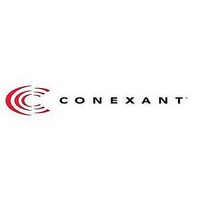cx28394 Conexant Systems, Inc., cx28394 Datasheet - Page 75

cx28394
Manufacturer Part Number
cx28394
Description
Quad/x16/octal-t1/e1/j1 Framers
Manufacturer
Conexant Systems, Inc.
Datasheet
1.CX28394.pdf
(305 pages)
- Current page: 75 of 305
- Download datasheet (3Mb)
CX28394/28395/28398
Quad/x16/Octal—T1/E1/J1 Framers
100054E
FIFO buffer is formatted differently than the transmit FIFO buffer. The Receive
buffer contains not only received messages, but also a status byte preceding each
message that specifies the size of the received message and the status of that
message. The message status reports if the message was aborted, received with a
correct or incorrect FCS, or continued. A continued message means the byte
count represents a partial message. When all message bytes are read, the buffer
contains another status byte. Message bytes can be differentiated from status
bytes in the buffer by reading the RSTAT1 bit in the RDL #1 Status register
[RDL1_STAT; addr 0A9]. RSTAT1 reports whether the next byte read from the
buffer will be a status byte or some number of message bytes.
can be tuned to the system’s CPU bandwidth. For systems with one dedicated
CPU, the data link status can be polled. For systems where a single CPU controls
multiple devices, the data link can be interrupt-driven. See
for a high-level description of polling and interrupt driven Receive Data Link
Controller software.
very little microprocessor interrupt overhead. Block transfers from the buffer can
be controlled by the Near Full Threshold in the FIFO Fill Control register
[RDL1_FFC; addr 0A7]. The Near Full Threshold is a user programmable value
between 0 and 63. This value represents the maximum number of bytes that can
be placed in the Receive buffer without the near full being declared. Once the
threshold is set, the Near Full Status (RNEAR1) in RDL #1 Status [RDL1_STAT;
addr 0A9] is asserted when the Near Full Threshold is reached. An interrupt,
RNEAR, in Data Link 1 Interrupt Status [ISR2; addr 009], is also available to
mark this event.
request register directing software to the lower levels (see Master Interrupt
Request register; addr 081 and Interrupt Request register; addr 003). Of all the
interrupt sources, the two most significant bandwidth requirements are signaling
and data link interrupts. Each data link controller has a top-level interrupt status
register that reports data link operations (see Data Link 1 and 2 Interrupt Status
registers [ISR2, ISR1; addr 009 and 00A). The processor uses a three-step
interrupt scheme for the data link:
The Receive Data Link FIFO #1 [RDL1; addr 0A8] is 64 bytes. The Receive
The receive data link controller has a versatile microprocessor interface that
Using the Receive FIFO buffer, an entire block of data can be received with
The device uses a hierarchical interrupt structure, with one top-level interrupt
1.
2.
3.
Read the Master Interrupt Request register to determine which framer
interrupted.
Read the Interrupt Request register for that framer.
Use that register value to read the corresponding Data Link Interrupt
Status register.
Conexant
Figures 2-5
2.0 Circuit Description
2.2 Receiver
and
2-6
2-17
Related parts for cx28394
Image
Part Number
Description
Manufacturer
Datasheet
Request
R

Part Number:
Description:
Bluetooth RF Transceiver
Manufacturer:
Conexant Systems, Inc.
Datasheet:

Part Number:
Description:
Bluetooth RF Transceiver
Manufacturer:
Conexant Systems, Inc.
Datasheet:

Part Number:
Description:
ATM transmitter/receiver with UTOPIA interface
Manufacturer:
Conexant Systems, Inc.
Datasheet:

Part Number:
Description:
Service SAR controller
Manufacturer:
Conexant Systems, Inc.
Datasheet:

Part Number:
Description:
CN8223EPFATM Transmitter/Receiver with UTOPIA Interface
Manufacturer:
Conexant Systems, Inc.
Datasheet:

Part Number:
Description:
Embedded modem family
Manufacturer:
Conexant Systems, Inc.
Datasheet:

Part Number:
Description:
Fully integrated T1/E1 framer and line interface
Manufacturer:
Conexant Systems, Inc.
Datasheet:

Part Number:
Description:
Flicker-free video encoder
Manufacturer:
Conexant Systems, Inc.
Datasheet:

Part Number:
Description:
Home Networking Physical Layer Device with Integrated Analog Front End Circuitry Data Sheet (Preliminary) CX82100-41Home Network Processor (HNP)
Manufacturer:
Conexant Systems, Inc.
Datasheet:

Part Number:
Description:
Manufacturer:
Conexant Systems, Inc.
Datasheet:

Part Number:
Description:
Manufacturer:
Conexant Systems, Inc.
Datasheet:

Part Number:
Description:
Manufacturer:
Conexant Systems, Inc.
Datasheet:

Part Number:
Description:
Flicker-free video encoder
Manufacturer:
Conexant Systems, Inc.
Datasheet:

Part Number:
Description:
SmartV.XX Modem
Manufacturer:
Conexant Systems, Inc.
Datasheet:

Part Number:
Description:
Multichannel synchronous communications controller
Manufacturer:
Conexant Systems, Inc.
Datasheet:










